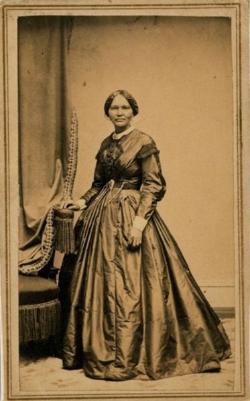Elizabeth Keckley (1818-1907)
Published: 7 March 2021
African American dressmaker, philanthropist, and civil activist

African American dressmaker, philanthropist, and civil activist
Born enslaved in Virginia to a mixed-race mother and her white owner, Elizabeth Keckley experienced an unorthodox childhood that would prove pivotal for her career. Taught to read and write, Keckley was trained in needlework to make clothes for her master’s family and his 70 slaves. Due to economic hardship, a move to St. Louis permitted the young seamstress to build a network of white clientele, with her wages supporting the seventeen-member family of her master upon his death. At the age of 38, Keckley purchased her freedom along with her son’s, settling in Baltimore with the aim of earning a living as a dressmaker. However, her attempts to train local African-American women to work as seamstresses failed, and she entered Washington D.C. with few financial resources. Utilizing her Missouri network, Keckley’s career was launched after constructing a silk dress for Mrs. Robert E. Lee whose appearance at a dinner soiree held for the Prince of Wales was highly lauded in elite circles. She gradually amassed steady client base of well-heeled politicians’ wives until being fatefully introduced to the newly-elected Abraham Lincoln and his wife Mary Todd. By 1861, Keckley was the First Lady’s primary modiste and remained her dressmaker and close confidant throughout her time in the White House. At the peak of her success, the designer employed 20 women in her 12th Street atelier in Washington D.C. Keckley utilized her status within the community to found the Ladies’ Contraband Relief Association, raising funds to aid the rising number of fugitive slaves in the nation’s capital during the Civil War. A falling out over the publication of Keckley’s 1868 autobiography Behind the Scenes led the dressmaker and widow Mary Todd to grow apart, forcing Keckley to find other sources of employment. Despite the success and fame which she had garnered over a relatively short period of time, Keckley was destitute at the end of her life. Impoverished and with failing health, Keckley spent her final years at the National Home for Destitute Colored Women and Children.
While receiving little attention upon her death, Keckley has re-emerged in historical scholarship and has received due credit for her pioneering work as an African-American seamstress and philanthropist at a time of institutionalized enslavement and prolonged racism post-emancipation. Keckley’s pioneering practice will serve as the foundation for my upcoming dissertation at the University of Glasgow, which will centralize around African-American seamstresses in the 19th century.
Keckley’s notable accomplishments include:
- First emancipated African-American dressmaker to the White House
- Founder of the National Home for Destitute Colored Women and Children
- Faculty Member of Wilberforce University
Stefan Romero, Postgraduate Student, MLitt Dress and Textile Histories
For more information on Elizabeth Keckley:
- Fleischner, Jennifer. Mrs. Lincoln and Mrs. Keckly : The Remarkable Story of the Friendship between a First Lady and a Former Slave. New York: Broadway Books, 2003.
- Keckley, Elizabeth. Behind the Scenes: Thirty Years a Slave, and Four Years in the White House. New York: Oxford University Press, 1989.
- Miller, Rosemary E. The Threads of Time, the Fabric of History: 38 Profile of Afro American Designers from 1850 to the Present. Virginia: T & S Publishing, 2007.
- Way, Elizabeth. “Elizabeth Keckly and Ann Lowe: Recovering an African American Fashion Legacy That Clothed the American Elite.” Fashion Theory 19, no. 1 (2015): 115-141.
First published: 7 March 2021

